We were in the Southwest corner of Wisconsin across the river from Iowa. This area was spared the leveling effects of the great glaciers that ground the rest of the state into gentler, rolling hills. Here the ridges run high and the valleys deep. Bordered on the west by the Mississippi River, this was the first part of the Wisconsin Territory to be populated by Europeans. They came to mine the area’s rich lead deposits, establishing a chain of small towns along the river that echoed their ethic heritage. We plan to drive the Great River Road to discover their history and charm of their communities.
Friday, August 7 we found a great stopping place at Grants River Recreation Area near Potosi, WI. We were on the banks of the
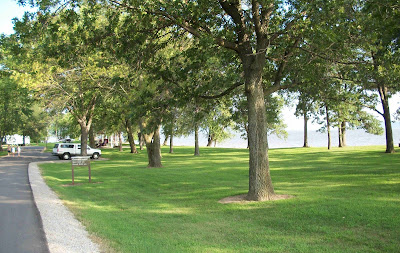.JPG)
Mississippi River and very close to the
.JPG)
train track following the river. We were told there were about 100 in 24 hours, and believed it. Even the trailer shook like a small earthquake as trains pass at 50 MPH. But we soon became accustomed to it and didn’t let it spoil the site. We enjoyed our supper of fresh vegetables, beets, spaghetti squash, tomatoes, onions, corn, and fresh Georgia peaches for desert. Daniel, we wished for you.
Saturday, August 7 we spent most of the day canning tomatoes. We found pretty good ones for $.40/lb. This is something we had missed doing the last two years because we didn’t find local tomatoes along our route. We were down to buying canned ones. Now we should have enough for the next year.
Sunday, August 8 we did not find a Methodist Church close and it rained, so we hibernated and stored the canning supplies. The campground host had told us about the 2010 Potosi Firemen’s Catfish Festival going on this weekend, culminating with the fish fry from 11:00 am—5:00 pm so when the sky cleared we took off for town.
The huge all volunteer fire station had been cleared for
.JPG)
tables. There was a long line waiting to go through the serving area. Another table was ready for seconds. They really knew how to feed a crowd, but they should have, they have been doing this for 50 years. This volunteer station has been
.JPG)
operating since 1834. Years ago someone made them
.JPG)
special burners and deep fryers just for this event once a year. There was another row of them behind this one. Fish was the only thing they fried. They have been using the same recipe from the beginning. The batter was light and very tasty. According to the men frying, the batter was made from beer, flour, salt and pepper.
Other food was potato salad, pasta salad, cold slaw and sliced rye and white bread and butter. No desert, but who needed it with all the fish you could eat!
From the fish fry we drove north along the Mississippi to Prairie du Chein where we wandered around driving through a big city park on the river. We realized this was where the city had once been before repeated flooding forced the town to relocate a half mile to higher ground. A few of the really large old buildings, built on a mound were still standing. We crossed the river into Iowa and visited the town of
.JPG)
McGregor nestled into the bluff and the main street rose as it went away from the river. From McGregor to Marquette was a
.JPG)
narrow highway under the bluff and next to the river.
South of McGregor the road rose up to a bluff containing exposure of the most complete of the Galena Group rock known. Galena refers to the lead ore which has been mined from this district for at least 300 years.
This valley
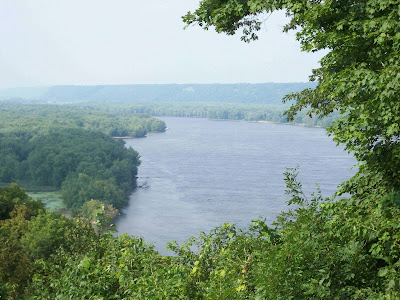.JPG)
was a natural corridor and an important route of both prehistoric and historic exploration, trade, settlement and transportation.
At Millville we boarded
.JPG)
a ferry for a trip down the river to Cassville. It was fun to play like we were early explorers or fur traders
.JPG)
traders traveling the river.
All along we have been admiring the soybean crop and how lush and tall it was. Olivia just had to get out and measure
.JPG)
how tall it was. Fred couldn’t believe soybeans could grow this tall.
Monday, August 9 we headed out to see some of Iowa by crossing the river at Dubuque and following Hwy 151 all the way to Amana. Along the way we saw rolling hills covered
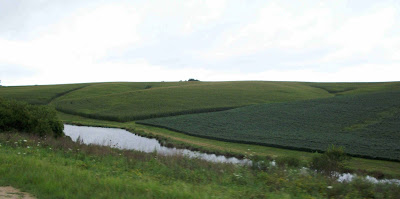.JPG)
with soybeans, corn and clover. Fred was not tall enough to reach the
.JPG)
top of the corn.
Arriving in Amana we parked in the Amana Colonies RV park then headed to the visitor’s center, went to the
.JPG)
museum to see the video and the
.JPG)
meat market for our brats for $1 and the
.JPG)
the Brewery for a taste before eating at one of their dining rooms.
The Amana colonies is one of America’s longest-lived communal societies, beginning in Germany and continues today on this Iowa prairie. Coming to Iowa in 1855 they purchased 26,000 acres and created Amana, East Amana, West Amana, South Amana, High Amana and Middle Amana and Homestead.
The residents received a home, medical care, meals, all household necessities and schooling for their children. Men and women were assigned jobs, no one received a wage. No one needed one. Farming and the production of wool and calico supported the community, but village enterprises, everything from clock making to brewing, were vital; and well-crafted products became a hallmark of the Amanas.
Over 50 communal kitchens provided three daily meals; as well as a mid-morning and mid-afternoon snack to all Colonists. They were well supplied by the village smokehouse, bakery, ice house and dairy and by huge gardens, orchards and vineyards maintained by the villagers.
In 1932, amidst America’s Great Depression, Amana set aside much of their communal way of life. They had a strong desire to maintain their community, but the communal way of life was a barrier to achieving individual goals, so rather than leave or watch their children leave, they changed. They established the Amana Society, Inc. a profit-sharing corporation to manage the farmland, the mills and the larger enterprises. The Amana Church was maintained.
Amana is not Amish, the two groups have very different historical traditions and religious teachings.
Tuesday, August 10 we joined a group of other interested tourists for a walking tour of the town. We learned a lot about the colonies and how the houses were built with
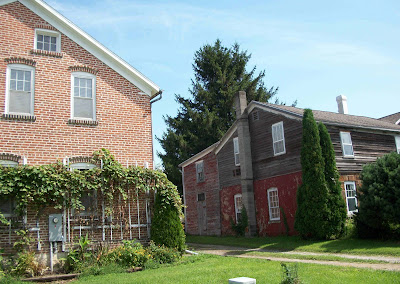.JPG)
trellis’s on the outside to grow grapes and windows with nine panes above and one below. The homes were actually apartments with each family having a bed room and living room. Kitchens were not needed as the central kitchens provided all their meals.
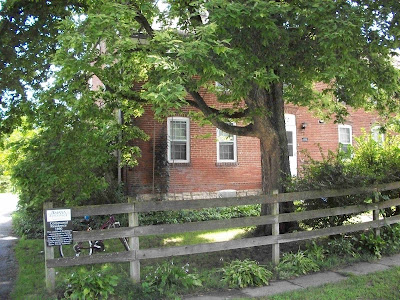.JPG)
The unpainted fences served to keep the animals out of the yards rather than children in. Large hallways connecting the apartments served as store rooms. Some buildings were brick, unpainted wood,
.JPG)
sandstone or combinations of all of the above.
After an hour and half we were too hot to enjoy the tour and retreated to some of the stores for air conditioning, then we took a drive into the country visiting the
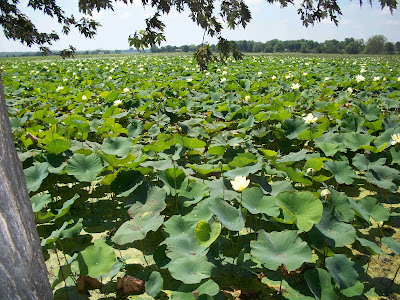.JPG)
Amana Lily pond that was full of the flowering plant and passing the thriving
.JPG)
Amana Whirlpool factory. Amana kitchen products are made here, but the factories were not owned by the society. It was a private endeavor owned by an individual who wanted to take advantage of the local laborers.
Then on to Tama and the Meskwaki Indian settlement to see the area talked about in the book
Shaman. Fred highly recommends this book.
We found Amana to be very humid and hot. It rained every day, or night. In fact for this general area it has been a very wet summer. Later, on the day we left Amana, a young girl drowned in flood waters about 40 miles west of Amana.
Wednesday, August 11, we moved north back to the Mississippi River just south of the borders of Wisconsin, Iowa, and Minnesota and another Corps of Engineer parks called Black Hawk park.
This was the location of the Battle at Bad Ax (1832) which was the last Indian-American battle fought east of the Mississippi River. After realizing the futility of fighting the US troops, Black Hawk’s British Band of Sauk attempted to escape across the river. At this point the last battle began, resulting in the deaths of nearly 150 of Black Hawk’s followers. This two-day battle took place in what is now the Black Hawk Recreation Park and the surrounding floodplain and uplands.
Black Hawk was searching for a peaceful resolution when he tried to cross the Mississippi. The men on the steamboat WARRIOR approached from upstream and the troops on board observed their presence. The Sauk stood unarmed along the shore and offered a white flag. Not trusting the Indians, they fired their six pounder and opened a fire of musketry. After two days of battle, the Indians were wiped out. This event is the culmination of the Black Hawk war we read about in history.
We found a
.JPG)
nice level site just a short distance from the river. We can see pleasure craft and barges moving up and down the river. Our elevation above the river is about
.JPG)
four feet.
We learned a lot about the timbering as an early business of this area.
After 1837 the vast timber resources of Northern Wisconsin were eagerly sought by settlers moving into the mid-Mississippi valley. By 1847 there were more than thirty saw-mills on the Wisconsin, Chippewa and St Croix river systems, cutting largely Wisconsin white pine.
During long winter months, logging crews felled and stacked logs on the frozen rivers. Spring thaws flushed the logs down the streams toward the Mississippi. Here logs were caught, sorted, scaled and rafted. Between 1937 and 1901 more than forty million board feet of logs floated down the Great River.
The largest log raft was assembled at Lynxville in 1896. it was 270’ wide and 1550’ long, containing two and one-fourth million board feet of lumber.
The largest lumber raft on the river originated on Lake St Croix in 1901. Somewhat smaller in size, 270’ wide and 1450’ long, it carried more lumber, nine million board feet. This all ended in 1915, ending a rich, exciting and colorful era in the history of Wisconsin and the Great River.
Thursday, August 12 we spent the day at the trailer and met two neighbors. One from Florida and the other from Bastrop, TX. Both have been to Alaska and gave us a lot of tips and suggestions. We now have several items to find and purchase, a generator, a CB, and the latest book Mile Post are at the top of the list.
The Texas couple had some inherited turquoise and we admired it. The Florida man is teaching himself how to paint and we showed him Muddie’s paintings on the computer. We ended the day with all six in one rig sharing stories. We enjoyed the interaction with both couples.
Friday, August 13 about 9 am it started raining and POURED for about two hours. It must have rained at least four inches. This area of the campground is fairly flat with no drainage, so we were in about a
.JPG) three inch puddle, which absorbed later in the day.
three inch puddle, which absorbed later in the day.
When the sun came out we drove up the river on the River road to Onalaska to investigate broad band solutions. Finding a Best Buy we didn’t find a good solution. We bought a few groceries and drove back on the Minnesota and Iowa side of the river to Lansing where we crossed and returned to the trailer. This was a good drive on both sides as we could see the river most of the time. At times is spreads out as much as three miles with islands and marshland which is good for the flyway and gives the birds good habitats. At other times we can see all the way across. The Corps of Engineers keep the river navigable with locks and dams at least to Minneapolis St Paul, which is about 200 miles north of us.
During our travels we have enjoyed our Sprint Air Card to attach to the internet and allow us keep up with our emails, find our next campground, keep up with the news/weather and post our blog, with unlimited time on Sprint and roaming connections. Tuesday of this week we had a disturbing email from Sprint telling us our air card would now limit the total data we send and receive at our flat price starting August 18. After two long discussions with Sprint we were also told if we go over they will disconnect our card until the next month starts or if we sign up for the new program we will be billed at $.25 per MB. When asked what our overage was this month already and what it would cost, we were told $164 over. ACK! So needless to say we were upset and this is why we were looking at a different solution. In the meantime we are cutting out all unnecessary time on the computer, not logging on until necessary, looking for WiFi, and trying to find Sprint coverage.
However, this next month we will totally be out of Sprint Coverage as we cover North and South Dakota. Because of all this we ask that you:
Please do not send us any pictures, or large files as this counts as data. We enjoy the pretty scenery and the cartoons the emails include, but this will count against us. We know you are thinking of us when you send and appreciate the thought. We still want to hear from you so conversation is great.
We will probably not post our blog on Face Book, unless we are on WiFi, as that is duplicating the original post and we are sure that is part of our problem.
We will cut out some of the blog pictures.
We are going to ask companies that send their newsletters to take us off their mailings.
We will continue to try to figure out a major solution to this problem.
If you have a good idea, please, let us know!
We appreciate your help and understanding. Thank you.
Saturday, August 14 we drove over to Lansing, Iowa to their Fish Days, but before going to the festival Fred stopped to get cappuccino and Olivia said, “I’m going across the street to see what this .JPG) sidewalk sale has.” After browsing the sale she started into the door and was met with wall to wall people, some coming, some trying to get out. When the way was clear she could see why it was so crowded as
sidewalk sale has.” After browsing the sale she started into the door and was met with wall to wall people, some coming, some trying to get out. When the way was clear she could see why it was so crowded as.JPG) each aisle was so narrow, only one person could fit. It was a hoot! Sure enough Olivia found a few trinkets and was told their other store was just a few doors up. By then Fred and browsed the store too and they both went to the second store where Olivia found Rada knives for a discount and the hard to find crew neck sweatshirts. Later at Fish Day, while eating their Fish sandwich and visiting with others, we found that Horsfall’s is famous all the way to the Texas Valley! On the way home we spotted a
each aisle was so narrow, only one person could fit. It was a hoot! Sure enough Olivia found a few trinkets and was told their other store was just a few doors up. By then Fred and browsed the store too and they both went to the second store where Olivia found Rada knives for a discount and the hard to find crew neck sweatshirts. Later at Fish Day, while eating their Fish sandwich and visiting with others, we found that Horsfall’s is famous all the way to the Texas Valley! On the way home we spotted a .JPG) houseboat almost under the bridge across the river from Lansing. This was not the typical houseboat we have been seeing on the Mississippi, but it was certainly unique, and we bet they have just as much fun as the fancy boats have.
houseboat almost under the bridge across the river from Lansing. This was not the typical houseboat we have been seeing on the Mississippi, but it was certainly unique, and we bet they have just as much fun as the fancy boats have.
On the way back to the trailer we hunted for the Methodist Church in DeSoto, WI. Actually we found it about five miles up the bluff on Wheatland Road. Duncanville folks, do those names ring any bells? There was a sign telling of their Brat’s and Corn fest at that time in the Retreat church hall. Nowhere was a hall found. We drove around the country side and no one was outside. Finally we found someone and he told us the circuit church was further on. We continued our search and found a crew in the kitchen preparing for their fund raiser. We entered and stated, “We’re hunting for a place to go to church tomorrow.” Of course, we were welcomed and invited. We were too full to stay for supper, but did buy two slices of home made pies for later. Yum! Yum!
Sunday, August 15, we attended the .JPG) Retreat UMC and again were welcomed and it was good to be back in church on Sunday after missing several weeks.
Retreat UMC and again were welcomed and it was good to be back in church on Sunday after missing several weeks.
This afternoon ended up being a maintenance day as we sort of cleaned house. Then we visited with the Bastrop couple and watched their movies of their trips to Alaska. Sure looks pretty up there. We are getting excited about going next year.
Monday, August 16 we hooked up and left this beautiful campground heading north along the Mississippi. At LaCrosse we crossed the river into Minnesota telling Wisconsin goodbye. The divided roadway surprised us and a scenic drive too. Almost total vision of the river all along.
In Winona we stopped to see the.JPG) Watkins Museum. This facility offered a glimpse into the past with its historical exhibits. What began in 1868 when J.R. Watkins perfected his direct sales strategy and guaranteed satisfaction is featured throughout the museum. It highlighted the success of Watkins products and the corporation through literature, product packaging, photos, and more. Their current product line has more than 350 products. Fred wonders if it was Watkins Cod Liver Oil his mother gave him each day when he was a kid. She swore by their Pepper and Vanilla until she quit cooking.
Watkins Museum. This facility offered a glimpse into the past with its historical exhibits. What began in 1868 when J.R. Watkins perfected his direct sales strategy and guaranteed satisfaction is featured throughout the museum. It highlighted the success of Watkins products and the corporation through literature, product packaging, photos, and more. Their current product line has more than 350 products. Fred wonders if it was Watkins Cod Liver Oil his mother gave him each day when he was a kid. She swore by their Pepper and Vanilla until she quit cooking.
We especially enjoyed the floor of the museum as it was made of wood blocks that absorbed the shock of the heavy printing machines. Over the years the wood blocks also absorbed drippings of ink and chemicals. These blocks looked just like the wood bricks that paved Rogers St in Waxahachie years ago.
Just a few more miles up the river was the town of Wabasha and the .JPG) National Eagle Center. This is an ideal location to see Eagles in the winter as Pepin Lake upstream has warm water near the bottom and as it empties, the water meets the Chippawa River coming from the north. The Mississippi at this point does not freeze and gives the birds an excellent place to fish. We were told in January and February it would not be uncommon to see 300 Eagles at once. Today we
National Eagle Center. This is an ideal location to see Eagles in the winter as Pepin Lake upstream has warm water near the bottom and as it empties, the water meets the Chippawa River coming from the north. The Mississippi at this point does not freeze and gives the birds an excellent place to fish. We were told in January and February it would not be uncommon to see 300 Eagles at once. Today we .JPG) saw five Eagles like Angel in the back. In July of 1999, Angel was a fledgling hanging out on the ground near the nest. A bone in her left wind had broken and healed improperly, so she could not fly. She probably survived by eating fish scraps that fell from nearby heron nests.
saw five Eagles like Angel in the back. In July of 1999, Angel was a fledgling hanging out on the ground near the nest. A bone in her left wind had broken and healed improperly, so she could not fly. She probably survived by eating fish scraps that fell from nearby heron nests.
She was taken to the U of M Raptor Center, but after surgery, her muscles were still too damaged for her to be released. She came to this National Eagle Center in March of 2000, and a 4th grade student gave her the name “Angel.”
There were two stories of excellent exhibits about the strength of these huge birds and remarkable capabilities of “Eagle eyes,” and in the air above there were two
.JPG) Eagles performing their mating flight. They grasp talons and fall almost to the ground before repeating this sky dance again.
Eagles performing their mating flight. They grasp talons and fall almost to the ground before repeating this sky dance again.
We attended an excellent program and heard all about Donald. Then after the program were privileged to .JPG) pose nose to beak with him.
pose nose to beak with him.
By this time we had to spend the night and found a lovely Passport America campground right down the street. But Fred twisted his back unhooking! Drats!
Tuesday, August 17, we continued north and to a regional park with full hookups and just for this week, half price camping. Can’t beat that!
After a rest we loaded up all the dirty clothes and found a nice laundromat.
Back at the trailer we challenged ourselves to decide what would be on the agenda for Minneapolis St Paul in the next two days. How much of our Waxahachie friend Joe Gallo’s list can we do?
Can’t wait to hear from you, so email us at Olivia@bobheck.com or fredharrington@yahoo.com
Next letter: Minneapolis St Paul and west Minnesota
